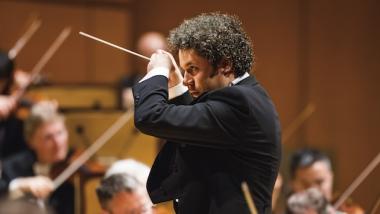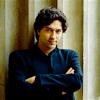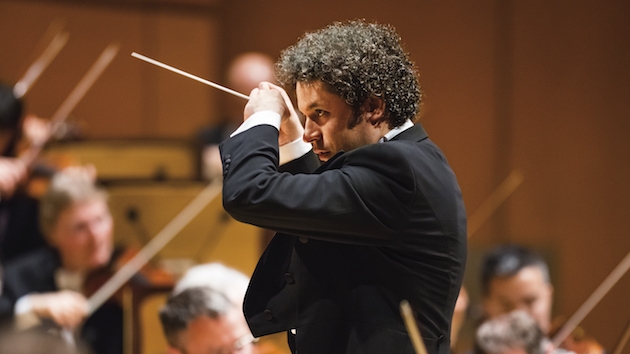
After a centennial year filled with so many special events — any one or two of which would have satisfied most orchestras in the span of a season — how could the Los Angeles Philharmonic bring everything to a culmination? They found a way.
On the very day, Oct. 24, 2019, in which the LA Phil turned 100, they invited their three living current and former music directors to share the Walt Disney Concert Hall spotlight Thursday night. Each now has a title: Zubin Mehta is the conductor emeritus, Esa-Pekka Salonen the conductor laureate, and Gustavo Dudamel the current music and artistic director. Their ages symmetrically span almost exactly a generation — Mehta is 83, Salonen 61 and Dudamel 38. And each had their role to play separately on a splashy gala night before they combined forces for a world premiere.
Salonen played the modernist, leading off the evening with probably the most important piece that the Philharmonic has commissioned over the decades, the Symphony No. 4 by Witold Lutosławski, a good friend of the orchestra in his last years. It was Lutosławski’s last major work, and in retrospect it often feels like a farewell; the lyrical, poignant opening for solo clarinet, harps, and Mahlerian strings is the most gorgeous thing that he ever wrote. Salonen’s understanding of the piece is deeper and more probing, the ad libitum outbursts sounded crazier than ever, the big sharp chords hit like rifle shots.
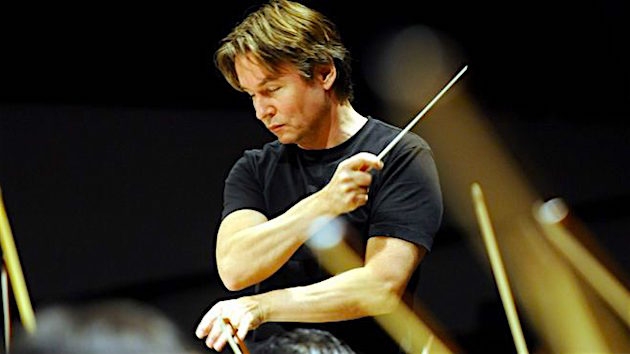
Now recuperated from recent surgery, walking to the podium with the aid of a cane and conducting while seated, Mehta played the grand old master, revisiting some signature Wagner (Prelude from Die Meistersinger) and Ravel (La Valse). The sound of the orchestra changed instantly from the clear, brilliant, unified textures of Salonen to the thick, heavy Mehta sound that he used to get from this orchestra and the Israel Philharmonic Orchestra alike. Mehta’s tempos in both pieces are now slower than they were when he was a fiery young tyro. His Wagner has mellowed, now with an eloquence in rhetoric that he had not yet acquired a half-century ago. His La Valse seemed more Viennese than ever in its rhythm and hesitations, the chaos at the finish still properly brutal. He flashed a big smile at times. It’s good to have him back in an official capacity here.
Dudamel played the showman, using his eyes more expressively than do his colleagues, with gestures big and small. His interpretation of Stravinsky’s 1919 suite from The Firebird didn’t have anything particularly unique to say — merely exclamation points on a straight-ahead concept — but he delivered an especially dynamic account of the “Infernal Dance,” delighting in its frenzied denouement, and he radiated joy in the Finale at maximum volume. The sound that Dudamel gets from his orchestra is hard to define, even after 10 years on the job, yet this performance had most of Salonen’s precision with jolts of his own brand of pasión.
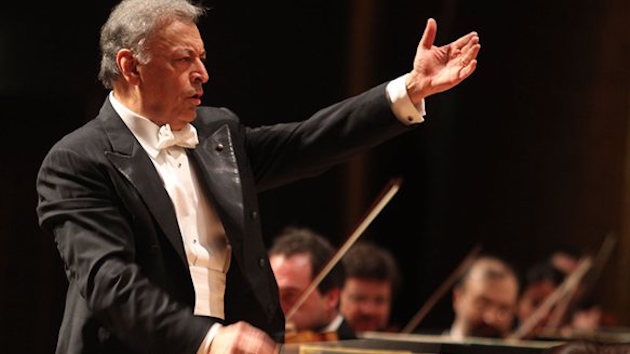
Finally came the summit meeting, a new 10-minute-long piece for three conductors and orchestra by Iceland’s Daniel Bjarnason, From Space I Saw Earth. There was a long pause for the complicated stage setup; with Dudamel up front conducting the strings; Mehta center-left in back leading the flutes, clarinets, brasses, piano, and percussion; and Salonen center-right in back in charge of the double reeds, duplicate brasses, and percussion. Throughout, Mehta and Salonen looked to Dudamel for cues.
The question I have is this: were three conductors really necessary for this piece? The troika of batons was put in the service of long, characteristically Icelandic drones, sheets of sound that grew louder and more dissonant until they reached a peak three-quarters of the way through. The music could suggest viewing earth from space, but also surveying the isolated, volatile landscape of Iceland itself. On a first listen from a seat directly overlooking the orchestra on the side, the textures sounded unified and anything but polyphonic — not like, say, the collisions of Charles Ives that could use multiple conductors.
But it was fun to watch and hear — and one can’t deny the historic specialness of the occasion. And in carrying out Bjarnason’s touching closing gesture, Mehta and Salonen whirled to their sides and cued in pairs of YOLA (Youth Orchestra of LA) kids in the aisles who gently struck hand-held crotales with mallets. As if to say: And a little child shall lead them into the future.

